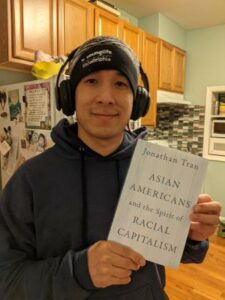Focus Group Report Given at March 2, 2022 Colloquium
Part of Educating Urban Ministers in Philadelphia After 2020 project
Background
The purpose of this focus group conversation was to understand the ramifications of COVID-19 on youth ministry in the Philadelphia area. For the focus group, we brought together people who represented diverse racial/ethnic/cultural backgrounds, denominations, spiritualities, and kinds of youth ministry. Most of the youth workers were connected to North Philadelphia. We also made sure to have both youth and youth leader representation present at the conversation.
One youth worker, a Puerto Rican woman, served in youth ministry at a Pan-Hispanic Pentecostal church while also working for an organization that trains youth workers locally. She also brought a youth from her youth ministry to participate in the conversation. Another youth worker, a black woman, was involved in a youth outreach ministry that serves youth in schools through relationship-building on their “turf”; she had also formerly served youth through church-based ministry. A Puerto Rican youth worker brought a teen from his sports-based youth outreach ministry to participate, though the teen himself remained a quiet observer during the entirety of the focus group conversation. Another youth worker, a white seminary student, has served both church teens and neighborhood teens through his church’s youth ministry. Lastly, a white woman connected to a church serving middle school church youth participated in the conversation.
In forming our questions, we attempted to bring up topics especially salient to Gen-Z without shaping the conversation through our own biases. After each person introduced themselves to the conversation, sharing a bit about themselves and their involvement in youth ministry, we discussed the topic of what observations they observed to be salient to the current state of youth and youth ministry, given the many forms of post-COVID-19 upheaval.
Conversation Themes
Relationship
In our initial conversations the participants focused on the theme of relationship. One person shared about seeing youth as being so diverse, coming from such different places, and consuming such different content, that creating lessons that really touch each youth in a room becomes difficult. His conclusion was that one-on-one relationships may be the only way to reach this next generation. Another person shared about the need to build relational presence and trust with youth before getting into conversations pertaining to Jesus and faith. She suggested that this generation of youth are more used to isolation, so social bonds may take more time to build. One of the youth shared about the importance of trust – that without the establishment of trust, her generation isn’t interested in what people may have to say about God, the Bible, or religion. She emphasized relationship over religion, confident that trusting relationships between youth and youth leaders opens youth up towards a relationship of trust in Jesus. Another youth leader emphasized the example of Jesus in building relationships with His disciples over time; this leader shared from his 10+ years of experience connecting with unchurched youth, offering this relational model as the way to reach teens. Additionally, he offered a critique of churches as often reticent to change; their prioritization of comfort leads to a failure to step into the world of youth to build trust. He observed that youth who do attend church tend to be the ones whose parents already attend. Another leader mentioned grassroots connection–taking young people out to eat, listening, asking questions, empathizing with their anxieties.
Race
One of the youth workers shifted the conversation to the jarring recent episodes of racial trauma. While adults and youth alike witnessed the “terrible videos of people dying in the streets,” she expressed the reality that youth need space to process and be heard. Another youth worker focused on the need for more black and brown folks to be included in these conversations.
Social Media
We then shifted the conversation towards social media. One youth worker shared about the way the Direct Message (DM) function in social media platforms has given youth freedom to be more honest and vulnerable in their sharing; she regularly experiences teens sharing things in DMs that they would not have had the boldness to share in face-to-face conversations. A teen agreed; she can share her whole life story through a screen, while in person she may find it difficult to even open up. Another youth worker shared that the pandemic was a wake-up call for churches regarding the need to leverage social media and technology. Because churches are often hung up on the fact that Gen-Z struggle with face-to-face conversations, they may fail to recognize the positives as well, which prevents them from leveraging these tools to effectively connect with youth. Another leader emphasized the way social media allowed him to attend more meetings through Zoom, which resulted in a more balanced schedule for his life. He expressed appreciation for churches that discern how to strategically use technology for God’s kingdom. One youth worker shared about a specific app that they found useful for facilitating regular communication between youth and parents.
Mental Health
In regards to mental health, another youth worker shared about how youth can often use social media as a way to “cry out” for help when facing mental health struggles. She shared about the need to learn to interpret youths’ ambiguous posts–are they anxious or suicidal? Are they having relational tension with their parents? She shared about the need to be paying attention to online posts to look for signs and symptoms of a mental health crisis. In response, a youth shared about the tactics she herself uses to hide her own pain. Seemingly light-hearted posts using dark humor often actually disguise deeper underlying struggles, and youth workers need to be attentive to these ambiguous subtleties to know how to reach out digitally to suffering youth.
Bridging Youth and Church
As we shifted the conversation towards the topic of helping the church understand and speak the language of the youth, one youth worker shared about Gen-Z having a “whole dictionary.” She shared about her own experiments and intentional attempts to learn their slang vocabulary, effectively creating a relational bridge towards youth. In attending to and even using their words, she is able to better pick up on different relational and emotional cues and to empower them more effectively. Another shared about the challenge of convincing churches that their parachurch work isn’t competing with the work of churches. She hopes for a collaborative relationship between different kinds of institutions to reach youth together.
Youth and Activism
When it comes to youth and activism, one leader shared about how youth learn so much from social media and other online sources that they have radically divergent views–some believe global warming is a myth, others are activists for social change; some distrust all online information. From his perspective, this generation is all over the map in their beliefs. Another youth worker shared about efforts with her youth to actively work for justice through anti-racist efforts. She emphasized the need to create safe spaces where youth’s perspectives can be heard, rather than lecturing them about the ways they are wrong. One youth worker shared the sentiment that youth are disappointed in older generations, consciously using Gen Z lingo to express the feeling: “It’s not giving what it was supposed to have gave.” Echoing her thought, a youth shared that they expected more. While she commended the positive effort in her church’s youth leaders to connect and relate to youth culture, she expressed a general disappointment in political leaders and older generations.
Imagining the Future of Youth ministry
Before closing out the conversation, we shifted the topic to their hopes for the future of youth ministry. One youth worker shared about being inspired by the example of the sports-based youth ministry, Timoteo, in its intentionality in creating leadership pipelines for discipleship multiplication, so that youth participating in the ministry become leaders who, in turn, empower other youth. Another youth worker expressed the need for churches to work on their language in relation to sexual or gender identity. Sharing about her church’s theological journey towards inclusion of sexual and gender minorities, she expressed that young people might be unwilling “to be part of a gospel that is not for everyone.” Another youth worker shared about being inspired watching their youth become excited about taking on the mantle of leadership, whether through offering lessons or leading games. One leader shared about the need to think ahead to remain innovative because living in the present already puts the church behind. Visionary youth ministry requires living in the future and acknowledging that Generation Alpha is already present. A Gen Z youth agreed that the attention has to already begin shifting towards Gen Alpha. Finally, another youth worker emphasized the need for more spaces for youth workers to process together and support each other in their efforts to reach the next generation.
Analysis and Findings
From the focus group we draw several tentative conclusions, relating to the topics of intentionality, processing space, and liminality.
Intentionality
The need for trusting relationships to form the basis for effective youth ministry, agreed on by everyone present in the focus group, should come as no surprise. This resonates with the findings of the Springside Research Institute, which has described the need for a shift away from relying on institutional authority towards gaining trust through “relational authority.” In describing the need to enter into the culture of youth through learning their slang, inhabiting their digital spaces and becoming students of their social norms, understanding their temperament towards current society and culture, participants saw youth as belonging to an identifiable subculture – if not one with uniform beliefs. These strategies offered for effectively ministering to youth can be seen as the kind of sound anthropological advice that would be offered as best practice to cross-cultural missionaries seeking to build bridges into another society–learn its culture, language, and social norms; cultivate trust before seeking to offer your own perspectives, especially in relation to metaphysical/religious beliefs. Indeed, in our postcolonial missiology, the emphasis has shifted towards the need for outside missionaries to frame their relationship with the “insiders” in a society as one of mutuality and exchange. If we are to see Gen Z (and Gen Alpha!) youth as culturally distinct enough to merit sustained attention, as their social media usage, attitudes in relation to social issues, and perception of institutions seems to suggest, then effectively reaching them for Christ will indeed require such missiological intentionality. Attentiveness to the creative grassroots strategies of ministries like Timoteo and other ministries that place adults in youth environments to build trust on their turf may be what is needed to gain cultural acumen in relation to the social norms of these emerging adults.
Processing space
While the conversations about preferring digital forms of communication over face-to-face communication may seem to suggest otherwise, intentionally-curated spaces for processing timely issues of significance will remain important to build trust with Gen Z. The issue of cultivating such spaces for dialogical conversation came up in the context of the topics of mental health, processing traumatic racial episodes, discerning social issues, and voicing opinions in relation to LGBTQ+ issues, and the future of youth ministry. Given the diversity of their opinions and the complexity of the realities that they are seeking to process, it will become increasingly important for adults to develop the necessary skills to cultivate social and conversational environments that allow youth to feel emotionally safe, connected, and curious while discussing matters of importance that concern them. Especially for churches that emphasize the primacy of the pulpit, creating additional spaces in which young people can bring alternative perspectives into dialogue with the teachings of the church will be necessary to help them integrate their thoughts towards synthesis and meaning.
Liminality
In general, the youth workers seemed to perceive the focus group as a safe space to process realities that they may not have been able to express elsewhere. Sharp critiques of “the church” were offered, as were suggestions about what churches must do to more effectively shape their environments to be amenable to youth. While the feeling of being caught between the unique challenges of today’s youth and the perceived prevailing culture of churches may be a perennial theme youth workers have often felt in the past, the increasing shift of Gen Z away from trusting institutional structures of religion and their active presence in digital spaces may represent a deepening divide between the young and old, such that youth workers may be feeling a stronger sense of liminality as they seek to bridge this gap. As youth workers expend themselves to listen to and empower youth, religious institutions will need to expend more energy in empathetically listening to their youth workers in their attempts to offer prophetic challenge, informed as they are by their dual location between church and youth culture.
Limitations
While the conversation was rich and yielded many important insights, a more in-depth understanding of youth and youth workers’ perception of Generation Z in our Post-COVID world would require many more such processing forums. One factor that may have shaped the course of this study was that several of the youth workers knew each other prior to this conversation. This may have affected the conversational dynamic, biasing them towards offering more homogenous perspectives. The person who brought up LGBTQ issues did not know any of the other youth or youth leaders before the focus group. Her comments did not yield any further additional comments pertaining to LGBTQ issues. This could have many possible explanations: the other youth workers could have simply had other issues they wanted to discuss, they could have lacked any strong opinions in relation to sexual and gender identity, they could have had a contrasting opinion but found it difficult to express to a stranger given the strong posture with which she shared her views, etc. Regardless, it seems clear that LGBTQ issues indeed will be an important reality for youth workers to become more fluent in addressing, and Christian churches will indeed need to grow in discerning how to wisely and lovingly hold space for such conversations in order to become, or remain, spaces that young people trust. Finally, while the people present at the conversation did offer a diverse representation of youth ministry in Philadelphia, a larger group of people, including more youth, would need to be gathered to offer a fully representative picture.


